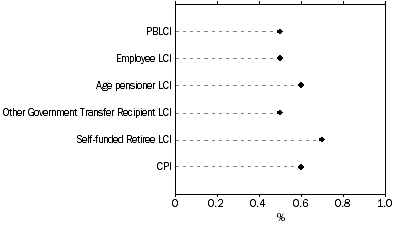June Key Statistics
The Living Cost Indexes (LCI)
The Living Cost Indexes (LCI) have been designed to answer the question:
'By how much would after tax money incomes need to change to allow households to purchase the same quantity of consumer goods and services that they purchased in the base period?'
In the June quarter 2019, the living costs of pensioner and beneficiary households (PBLCI) rose 0.5%. Over the same period, the living costs of self-funded retiree households rose 0.7%, age pensioner households rose 0.6%, employee households and other government transfer recipient households both rose 0.5%. For more information about the June quarter 2019 results see Main Contributors to Change.
The inclusion of mortgage interest and consumer credit charges, and the different treatments of housing and insurance costs in the LCIs result in variations between the LCIs and the Consumer Price Index (CPI). The expenditure patterns of those households measured by the LCIs differ from those of the overall household sector in scope of the CPI; these also contribute to differences in the percentage changes.
For a discussion of the relationship between the LCIs and CPI, see the Explanatory Notes.
 |  | Mar Qtr 2019 to Jun Qtr 2019 | Jun Qtr 2018 to Jun Qtr 2019 |
| Weighted average of eight capital cities, All groups | % change | % change |
|
| Selected Living Cost Indexes (LCIs) - Household type: |  |  |
 | Pensioner and Beneficiary LCI (PBLCI) | 0.5 | 1.9 |
 | Employee LCI | 0.5 | 1.6 |
 | Age pensioner LCI | 0.6 | 1.9 |
 | Other Government Transfer Recipient LCI | 0.5 | 1.9 |
 | Self-funded Retiree LCI | 0.7 | 2.0 |
| Consumer Price Index (CPI) | 0.6 | 1.6 |
|
Percentage change for Household type
 |  |
Time series data
Longer time series of statistics presented in this product are available from the Downloads tab for this product on the ABS website. They are available as Time Series Workbooks:
- TABLE 1. All Groups, Index Numbers and Percentage Changes, by Household Type
- TABLE 2. Commodity Groups, Index Numbers, Percentage Changes and Points Contributions, by Household Type
- TABLE 3. Gross Insurance, Mortgage Interest and Consumer Credit, Index Numbers and Percentage Changes, by Household Type
Use of Price Indexes in Contracts
Price indexes published by the Australian Bureau of Statistics (ABS) provide summary measures of the movements in various categories of prices over time. They are published primarily for use in Government economic analysis. Price indexes are also often used in contracts by businesses and government to adjust payments and/or charges to take account of changes in categories of prices (Indexation Clauses).
Use of Price Indexes in Contracts that sets out a range of issues that should be taken into account by parties considering including an Indexation Clause in a contract using an ABS published price index.
Frequently Asked Questions
The
Frequently Asked Questions page that has answers to a number of common questions to do with price indexes and the Consumer Price Index, in particular.
 Print Page
Print Page
 Print All
Print All
 Quality Declaration
Quality Declaration